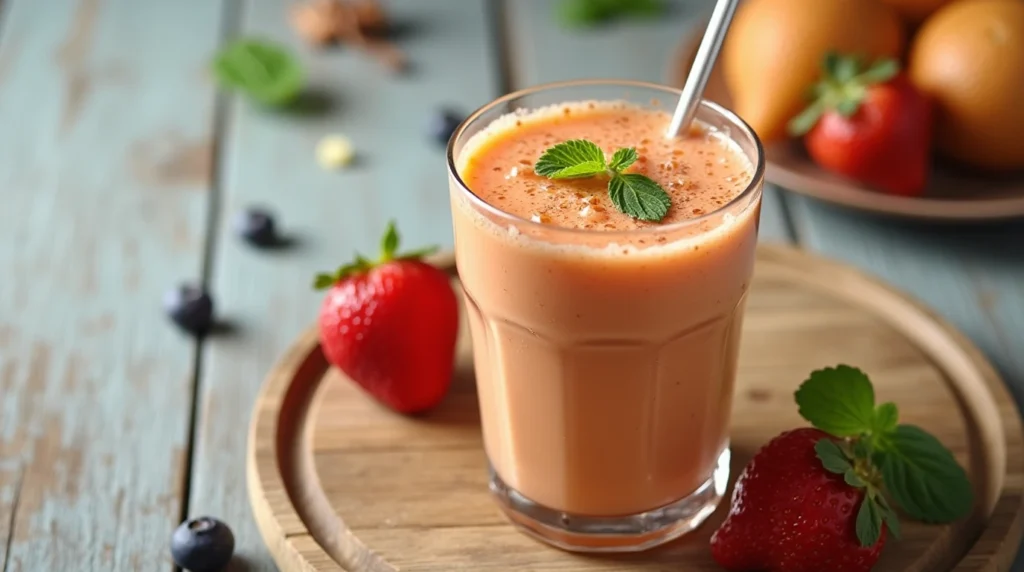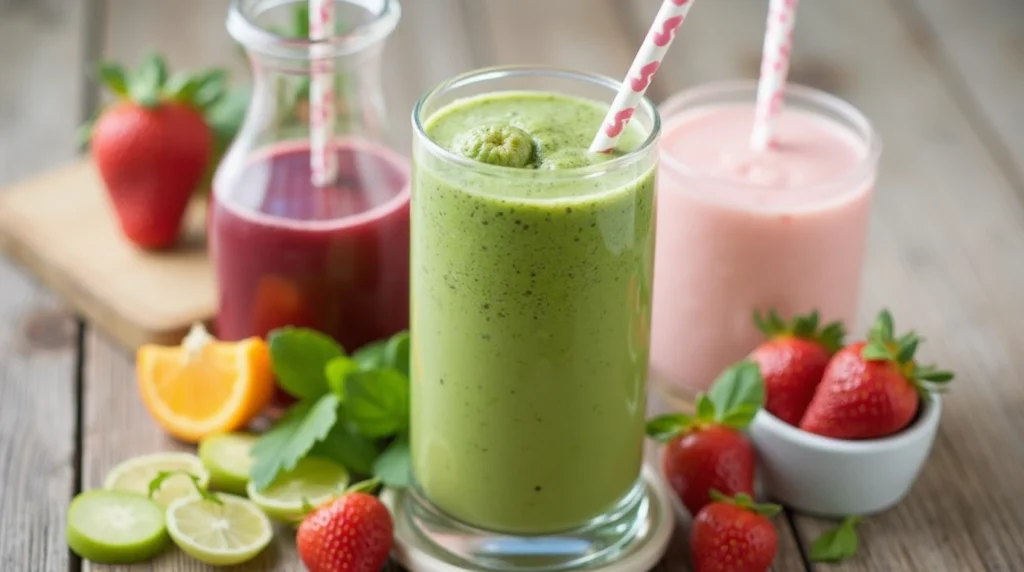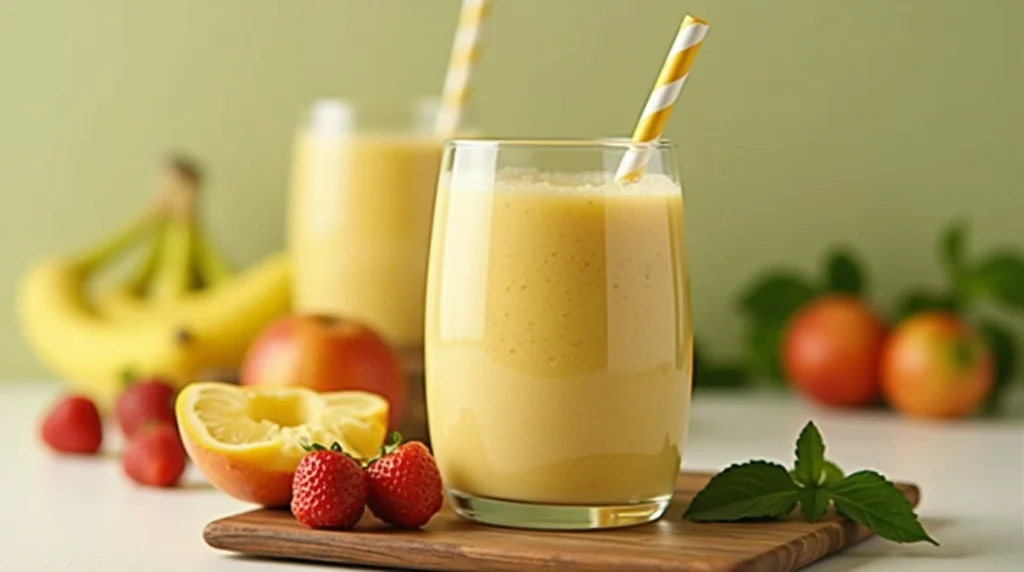Introduction

You’ve probably heard it before—smoothies are a quick, nutritious way to fuel your body. But let’s face it, most people think healthy smoothies taste like wet grass or bland mush. If you’ve ever wondered how to make a healthy smoothie that actually tastes amazing, you’re in the right place.
Imagine this: You wake up groggy, craving something delicious yet wholesome. Instead of reaching for sugary cereal or a greasy breakfast sandwich, you whip up a vibrant, creamy smoothie packed with vitamins, minerals, and flavor that makes you feel unstoppable. Sounds dreamy, doesn’t it? Well, today we’ll show you exactly how to create that magic in your blender.
What Makes a Smoothie Truly Healthy?
When crafting a healthy smoothie, it’s not just about throwing random fruits and veggies into a blender. A truly nourishing drink requires thoughtful ingredient choices. Let’s break down what sets apart a genuinely healthy smoothie from one that might sabotage your goals.
Choose Whole, Nutrient-Dense Ingredients
- Fruits like bananas, berries, and mangoes provide natural sweetness and antioxidants.
- Vegetables such as spinach, kale, and avocado offer fiber, vitamins, and creaminess without overpowering flavors.
- Plant-based milks (e.g., almond milk, oat milk) or Greek yogurt serve as excellent bases while adding calcium and protein.
Key Insight: Whole foods retain more nutrients compared to processed alternatives.
Watch Out for Hidden Sugars
- Avoid store-bought smoothies loaded with refined sugars or syrups.
- Opt for natural sweeteners like honey, maple syrup, or dates when needed.
- Remember, ripe fruit alone can often satisfy your sweet tooth.
Fact: The American Heart Association recommends no more than 25g of added sugar per day for women and 36g for men.
Balance Your Macronutrients
- Protein: Keeps you full longer; try Greek yogurt, protein powder, or nut butters.
- Healthy Fats: Supports brain health; include avocado, chia seeds, or flaxseeds.
- Fiber: Promotes digestion; found in fruits, vegetables, and whole grains.
Tip: Aim for a mix of all three macronutrients for sustained energy.
Keep Portions in Check
- Even healthy ingredients can add up calorically. Stick to reasonable serving sizes.
- Example: One banana + half an avocado + a handful of spinach is plenty.
Reminder: Overdoing portion sizes may lead to unintentional weight gain.
Must-Have Ingredients for a Tasty and Nutritious Smoothie
Now that you know what makes a smoothie healthy, let’s dive into the star players that will elevate both taste and nutrition.
Base Liquids That Add Creaminess and Flavor
- Almond milk: Light and slightly nutty.
- Coconut water: Hydrating and subtly sweet.
- Oat milk: Creamy and rich in fiber.
- Greek yogurt: Adds thickness and protein.
Fruits That Add Natural Sweetness
- Banana: Creamy texture and mild sweetness.
- Mango: Tropical flair with vitamin C.
- Berries: Low-calorie, antioxidant-packed options.
- Pineapple: Zesty and refreshing.
Greens That Are Mild in Taste
- Spinach: Virtually undetectable once blended.
- Kale: Slightly earthy but pairs well with fruit.
- Avocado: Boosts creaminess without altering flavor.
Optional Boosters and Superfoods
- Protein powder: Ideal post-workout recovery.
- Chia seeds: Omega-3 fatty acids and fiber.
- Flaxseeds: Rich in lignans and heart-healthy fats.
- Nut butters: Peanut butter or almond butter for richness.

How to Make a Healthy Smoothie Step-by-Step
Ready to get blending? Follow these simple steps to craft your perfect smoothie every time.
Start With Your Liquid Base
- Begin with about 1 cup of your chosen liquid (e.g., almond milk, coconut water). This ensures proper blending consistency.
Add Fruits and Veggies
- Combine fresh or frozen produce for optimal flavor and texture.
- For example, pair sweet pineapple with earthy spinach.
Include Protein and Healthy Fats
- Incorporate sources like Greek yogurt, chia seeds, or almond butter to keep you satiated.
Blend and Taste-Test
- Blend until smooth, then adjust sweetness or thickness by adding more fruit, liquid, or ice.
Delicious Smoothie Combinations You’ll Love
Here are four tried-and-true recipes guaranteed to please your palate.
| Smoothie Name | Ingredients |
|---|---|
| Tropical Glow-Up | 1 banana, 1 cup mango chunks, 1 cup coconut milk, 1 tbsp chia seeds |
| Green Energy Boost | 1 cup spinach, ½ cup pineapple chunks, 1 banana, 1 cup almond milk |
| Berry Antioxidant Blend | ½ cup blueberries, ½ cup strawberries, ½ cup Greek yogurt, 1 tsp flaxseed |
| Creamy Avocado-Cocoa | ½ avocado, 1 banana, 1 tbsp cocoa powder, 1 tbsp almond butter, 1 cup almond milk |
Pro Tips for Making the Best Healthy Smoothie
Take your smoothie game to the next level with these expert tips.
Freeze Your Fruit for a Creamier Texture
- Frozen fruit eliminates the need for ice, resulting in a thicker blend.
Use a High-Speed Blender for Best Results
- Brands like Vitamix or NutriBullet ensure smooth textures, even with tough greens.
Sweeten Naturally—If at All
- Rely on ripe fruit first; use natural sweeteners sparingly if necessary.
Prep Smoothie Packs for Busy Days
- Portion out ingredients in freezer bags ahead of time for grab-and-go convenience.
What Makes a Smoothie Truly Healthy?
Understanding the fundamentals of a healthy smoothie goes beyond just tossing greens and fruits into a blender. Here’s an expanded look at what makes these drinks truly nourishing while still being delicious.
Choose Whole, Nutrient-Dense Ingredients
When selecting ingredients, prioritize whole foods that are minimally processed. These retain their natural nutrients and offer a host of health benefits.
- Fruits:
- Bananas: High in potassium, which supports heart health and muscle function.
- Berries: Packed with antioxidants like anthocyanins, which combat inflammation.
- Mangoes: Rich in vitamin A, essential for eye health and immune support.
Pro Tip: Use frozen fruit not only for texture but also because freezing locks in nutrients.
- Vegetables:
- Spinach: Contains iron, magnesium, and folate, all critical for energy production.
- Kale: Loaded with vitamins K, C, and A, plus anti-inflammatory properties.
- Avocado: Provides monounsaturated fats, promoting heart health and satiety.
Science Backed: A study published in Nutrients highlights how leafy greens improve gut microbiota diversity, aiding digestion.
- Plant-Based Milks & Yogurts:
- Almond milk: Low in calories but fortified versions often contain calcium and vitamin D.
- Oat milk: Naturally sweet and rich in beta-glucans, known to lower cholesterol.
- Greek yogurt: High in protein and probiotics, supporting gut health.
Watch Out for Hidden Sugars
Sugar sneaks into smoothies in surprising ways. Even seemingly “healthy” juices or flavored yogurts can be loaded with added sugars.
- Why It Matters: Excess sugar consumption has been linked to increased risks of obesity, type 2 diabetes, and heart disease.
- Natural Sweeteners vs. Artificial Ones:
- Dates: Provide fiber along with sweetness, making them a better choice than refined sugars.
- Honey: Contains trace amounts of vitamins, minerals, and antioxidants.
- Maple Syrup: Rich in manganese and zinc, though still calorically dense.
Key Takeaway: Always check labels on packaged ingredients to avoid hidden sugars.
Balance Your Macronutrients
A well-rounded smoothie keeps you energized and satisfied. Here’s how to achieve macronutrient harmony:
- Protein Sources:
- Greek yogurt: Offers up to 10g of protein per serving.
- Protein powders: Whey, pea, or hemp protein are great options depending on dietary preferences.
- Nut butters: Peanut butter adds about 4g of protein per tablespoon.
- Healthy Fats:
- Avocado: Adds creaminess and provides omega-9 fatty acids.
- Chia seeds: Contain ALA (alpha-linolenic acid), an omega-3 fatty acid beneficial for brain health.
- Coconut oil: Medium-chain triglycerides (MCTs) may boost metabolism.
- Fiber-Rich Options:
- Flaxseeds: High in soluble fiber, which helps regulate blood sugar levels.
- Berries: Low glycemic index fruits that prevent spikes in insulin.
Bonus Insight: Research from The Journal of Nutrition shows that combining protein, fat, and fiber leads to prolonged feelings of fullness.
Keep Portions in Check
Even healthy ingredients can add up quickly if portions aren’t monitored.
- Calorie Awareness Tips:
- Measure out servings instead of eyeballing them.
- Stick to one serving of fruit (around ½ cup) unless using low-calorie options like berries.
- Limit high-calorie add-ins like nut butbers to 1–2 tablespoons.
- Portion Control Example:
- Base liquid: 1 cup almond milk (~30 calories).
- Fruit: ½ banana + ½ cup berries (~50–70 calories).
- Greens: 1 cup spinach (~7 calories).
- Protein: 2 tbsp chia seeds (~120 calories).
Total: ~200–250 calories—a perfect snack-sized smoothie.

Must-Have Ingredients for a Tasty and Nutritious Smoothie
Let’s explore additional nuances within each category of must-have ingredients to help you fine-tune your smoothie creations.
Base Liquids That Add Creaminess and Flavor
Your choice of liquid sets the foundation for flavor and texture.
- Almond Milk:
- Pros: Light, neutral flavor; ideal for weight-conscious individuals.
- Cons: Lower in protein compared to other milks.
- Coconut Water:
- Pros: Naturally hydrating due to electrolyte content (potassium).
- Cons: Can impart a slight coconut taste, which may not pair well with certain recipes.
- Oat Milk:
- Pros: Creamier than almond milk; often fortified with vitamins.
- Cons: Higher in carbs, so consider this if watching carb intake.
- Greek Yogurt:
- Pros: Thickens smoothies beautifully while adding tangy flavor.
- Cons: Not suitable for vegans or those avoiding dairy.
Expert Advice: For creamy vegan smoothies, blend silken tofu with plant-based milk as a substitute for yogurt.
Fruits That Add Natural Sweetness
Different fruits bring unique textures and flavors to the table.
- Banana:
- Creates a thick, velvety consistency when blended.
- Freezing bananas beforehand enhances creaminess further.
- Berries:
- Blueberries: Anti-inflammatory powerhouse.
- Strawawberries: Brighten up any smoothie with their tartness.
- Pineapple:
- Tropical flair with digestive enzymes like bromelain.
Fun Fact: Pineapple pairs exceptionally well with ginger for a zesty kick.
Greens That Are Mild in Taste
Greens are nutritional powerhouses, but some varieties can overwhelm delicate palates.
- Spinach:
- Virtually undetectable once blended, especially with sweeter fruits.
- Rich in nitrates, which improve blood flow and oxygen delivery.
- Kale:
- Slightly bitter, but milder baby kale works wonders.
- Massaging kale before blending reduces bitterness.
- Avocado:
- Silky texture without altering flavor profile significantly.
- Adds healthy fats, keeping hunger pangs at bay.
Tip: Start small—add a handful of greens and gradually increase as your palate adjusts.
Optional Boosters and Superfoods
Boosters take your smoothie to the next level nutritionally and sometimes even aesthetically.
- Protein Powder:
- Ideal for post-workout recovery or meal replacements.
- Look for unflavored or vanilla options to maintain versatility.
- Chia Seeds & Flaxseeds:
- Both are rich in omega-3s and fiber. Grind flaxseeds for better absorption.
- Matcha Powder:
- Concentrated source of antioxidants, including EGCG.
- Adds a vibrant green hue and earthy flavor.
- Cacao Powder:
- Raw form of chocolate, packed with magnesium and flavonoids.
- Perfect for indulgent yet guilt-free treats.
Note: Avoid overloading on superfoods, as they can become expensive and overpowering.
How to Make a Healthy Smoothie Step-by-Step
Now that we’ve covered the essentials, let’s walk through the process of crafting your smoothie with precision and creativity. These step-by-step instructions will ensure you achieve the perfect balance of flavor, nutrition, and texture every time.
Start With Your Liquid Base
The liquid base is the foundation of your smoothie—it determines consistency and helps blend all ingredients smoothly.
- How Much to Use:
- Begin with about 1 cup (8 ounces) of liquid. Adjust as needed based on desired thickness.
- Too little liquid can cause blending issues; too much dilutes flavors.
- Choosing Based on Goals:
- For hydration-focused smoothies, opt for coconut water or plain water.
- To boost creaminess, go for oat milk or Greek yogurt mixed with almond milk.
Tip: If using frozen fruit, reduce the amount of liquid slightly since frozen produce releases moisture during blending.
Add Fruits and Veggies
Fruits and veggies are where most of the flavor and nutrients come from. Here’s how to layer them effectively:
- Layering Order:
- Place greens like spinach or kale at the bottom near the blades for thorough blending.
- Add softer fruits like bananas or berries next.
- Balancing Sweet and Earthy Flavors:
- Pair sweet fruits (banana, mango) with mild greens (spinach).
- Use citrus fruits (orange, lemon juice) to brighten earthy vegetables like kale.
Pro Hack: Freeze overripe bananas or leftover fruit in ziplock bags for future smoothies. This reduces food waste and saves money.
Include Protein and Healthy Fats
Adding protein and healthy fats ensures your smoothie keeps you full and energized.
- Options for Protein:
- Greek yogurt: Adds tanginess and thickness while packing protein.
- Protein powder: Choose unflavored or vanilla for maximum versatility.
- Sources of Healthy Fats:
- Avocado: Makes smoothies ultra-creamy without altering taste significantly.
- Nut butters: Peanut butter, almond butter, or cashew butter add richness.
Reminder: Stick to 1–2 tablespoons of nut butter to avoid excessive calories.
Blend and Taste-Test
Blending is both an art and a science. Follow these steps for flawless results:
- Blending Technique:
- Start on low speed to break down tough ingredients like greens.
- Gradually increase speed to high for a velvety finish.
- Taste Testing Tips:
- Take a small sip after initial blending. Adjust sweetness by adding honey, dates, or more fruit if needed.
- Thicken overly watery smoothies with frozen fruit or ice cubes.
Tool Recommendation: Invest in a high-speed blender like Vitamix or Blendtec for superior performance, especially when working with fibrous greens or hard nuts/seeds.

Delicious Smoothie Combinations You’ll Love
To inspire your culinary creativity, here are four additional smoothie recipes along with their nutritional profiles. Each combination highlights unique flavors and health benefits.
| Smoothie Name | Ingredients | Nutritional Highlights |
|---|---|---|
| Citrus Sunrise | 1 orange, ½ grapefruit, 1 carrot, 1-inch ginger, 1 cup coconut water | Vitamin C boost + anti-inflammatory properties |
| Chocolate-Peanut Power | 1 banana, 1 tbsp cocoa powder, 1 tbsp peanut butter, 1 cup almond milk, 1 scoop protein powder | Rich in magnesium + satiating protein |
| Peach-Mango Delight | 1 cup peaches, ½ cup mango chunks, 1 cup spinach, 1 cup oat milk | High in beta-carotene + fiber |
| Blueberry-Almond Bliss | 1 cup blueberries, 1 tbsp almond butter, 1 tbsp flaxseeds, 1 cup coconut milk | Omega-3s + antioxidants |
FAQ Section
Q1: Can I make a healthy smoothie without using dairy?
Yes! Swap dairy for plant-based milks like almond or oat milk, and opt for non-dairy yogurts.
Q2: How do I avoid making my healthy smoothie too watery?
Use less liquid initially and gradually increase until you reach your desired consistency.
Q3: Is it okay to use frozen vegetables in a healthy smoothie?
Absolutely! Frozen spinach or cauliflower works wonders for texture and nutrition.
Q4: Why does my smoothie taste bitter?
Bitterness often comes from unripe fruits or strong-tasting greens. Balance with sweeter fruits like bananas or mangoes.
Q5: How many calories should a healthy smoothie have?
It depends on your goals, but aim for 200–400 calories for a balanced meal replacement.
Conclusion
Healthy smoothies don’t have to be boring or bland—they can be vibrant, flavorful, and incredibly satisfying. By choosing nutrient-dense ingredients, balancing macronutrients, and experimenting with creative combinations, you can craft drinks that support your wellness journey and delight your taste buds.
We’d love to hear about your favorite smoothie creations! Share your go-to recipe in the comments below or tag us on social media so others can try it too. Happy blending!
